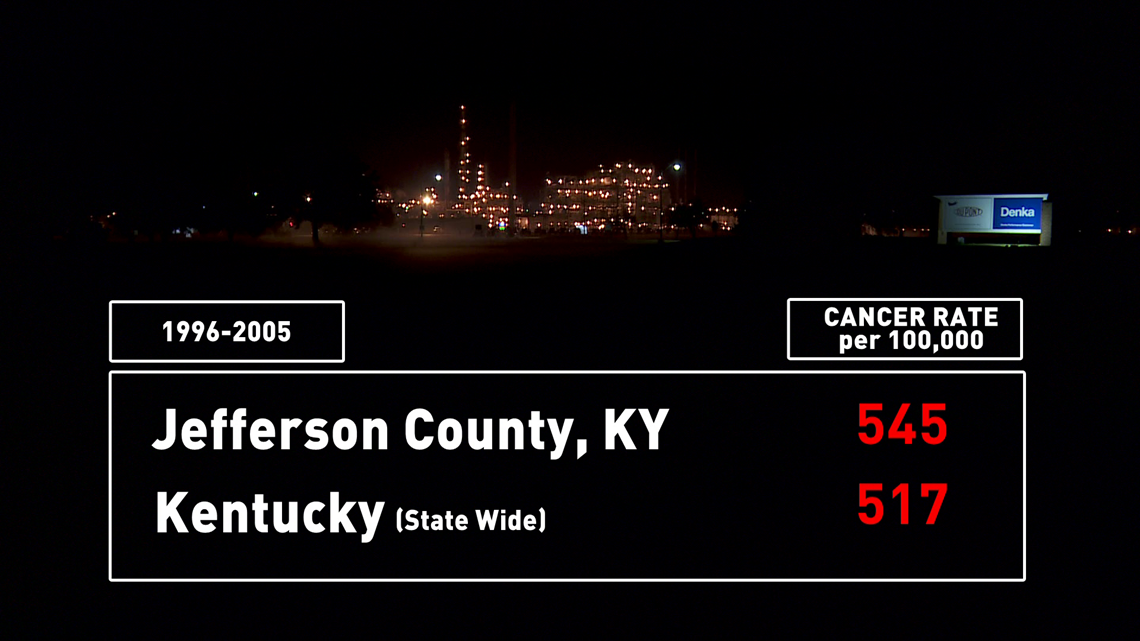This story is part two of a three-part series exploring the infamous "Cancer Alley" along the river parishes of southeast Louisiana. Click here to read part one or Click here to read part three of the series.
---
Kerry Henry is about to head back to the doctor, hoping he won’t have to do any more radiation treatments for his esophageal cancer.
“You can't eat,” he said, looking back on three years of grueling treatments. “It's gonna burn you coming down because the radiation. Just like a microwave, you know?”
Henry was a supervisor at a Marathon oil refinery until his cancer forced him to retire. But he doesn't blame his old employer for making him sick. He blames the DuPont-Denka chemical plant a few blocks from his house for poisoning him and many others in St. John the Baptist Parish.


“You could walk around here and a lot of houses you go to, a lot of people had cancer. And they never knew why they had cancer. And this is where it's coming from. From DuPont,” Henry said.
The idea that the DuPont-Denka plant is causing people's cancer is based on a 2015 study by the U.S. Environmental Protection Agency. That report found the chemical chloroprene, which the DuPont-Denka facility has been using – and then emitting – in the production of the synthetic rubber chloroprene for the last 49 years, puts the people in St. John at the highest risk of getting cancer from breathing the air in the entire country.
The EPA says the neighborhood closest to the plant has a cancer risk factor of 832-in-a-million. Of 73,000 census tracts nationwide, all of the Top 5 neighborhoods for airborne cancer risk, and seven of the Top 10 are in St. John.
But strangely, that enormous risk level calculated by the EPA has not translated into more actual cancer cases in St. John.
The LSU Tumor Registry, which collects all cancer diagnoses for Louisiana residents, shows the actual cancer incidence rate in St. John between 2010 and 2014 was 463 per 100,000 people. That’s below the statewide average of 478 per 100,000 residents.
Louisiana Environmental Protection Secretary Chuck Carr Brown says that’s why he does not believe there is an imminent health threat from the chloroprene emissions in St. John.
“I'm a firm believer in data, I'm a firm believer in making decisions that are rooted in science. That's how I operate,” Brown said. “So it gives us time to work on a solution to reduce chloroprene.”
Brown started working on that solution when he took office in 2016. He quickly got a commitment from the plant's new Japanese owners, Denka Performance Elastomers, to cut emissions at the plant by 85 percent.
Over the last year, Denka has spent more than $30 million installing two condensers to recapture chloroprene byproduct and two burners to destroy it. The largest burner is called a Regenerative Thermal Oxidizer. It took most of 2017 to build and install at a cost of about $18 million, and Denka has been testing it over the last two months.


The state gives the plant a permit to release up to 201 tons of chloroprene into the air per year. It averages around 120 tons per year, and Denka hopes the new equipment will lower that to about 18 tons over the coming year.
“If it was feasible (to reduce the emissions), and they knew it was feasible, why wait till all the commotion come up to, you know, do it?” asked David Sanders, who has lived directly across the fence from the DuPont-Denka facility for 60 years and believes the chloroprene emissions are to blame for his chronic respiratory and neurological conditions.
DuPont declined to answer questions about why it didn’t reduce emissions before it sold the chloroprene operations to Denka in late 2015. DuPont still owns the land the plant is on, leases the chloroprene portion to Denka and still runs other chemical operations on about a third of the property.
In a statement to WWL-TV, the company said it always kept its chloroprene emissions below the state permit limit and disputes the EPA’s assessment of chloroprene’s toxicity.
Plant Manager Jorge Lavastida, a former DuPont employee who now works for Denka, says the Japanese firm didn't know what it was getting into when it bought the chloroprene operations from DuPont on Nov. 1, 2015, just one month before the EPA released its cancer risk study. He said Denka was blindsided by the study and was not aware of a 2010 report by the EPA that determined chloroprene was a likely carcinogen.


Asked why a company that produces chloroprene would not know about its carcinogenic qualities, Lavastida said the Japanese firm is new to the U.S. and the EPA’s assessment process.
Lavastida called the EPA’s use of tests on rats and mice to calculate a human cancer risk for chloroprene “faulty science.”
“They applied the data they got from the mice directly to humans and there are models that can actually do that better,” he said.
When it released that report on chloroprene in 2010, the EPA set 0.2 micrograms of chloroprene per cubic meter of air as a safe concentration. Instead, Denka argues the safe concentration should be 156 times higher, or 31.2 micrograms per cubic meter.
Last month, the EPA rejected Denka's argument for a second time. Still, Lavastida says Denka is working with EPA to reduce its chloroprene emissions.
“We may not share the science about it, but we understand the concern, that when EPA says something the community is going to be concerned and we're going to respond to that,” he said.
Brown said he wants to see how much Denka can limit emissions before setting an enforceable statewide standard for chloroprene.
“There was never a doubt that the amount of chloroprene would have to be reduced,” Brown said. “What that number ends up being, we don't know that just yet.”
But Henry thinks the state is just stalling because chloroprene limits have been set for over a decade, at least in Kentucky.
The only other chloroprene plant in America used to be the DuPont-Dow Elastomer plant in the Rubbertown section of Louisville, Ky. But the city of Louisville established new emissions control standards in 2005, and in 2008, the Louisville plant was closed.


“DuPont decided that they weren't going to spend all the money to put in all the control technologies there, they decided to shut it down and move it here,” said Wilma Subra, an environmental scientist who worked to set the air-quality control standards in Louisville.
DuPont says it closed the Louisville plant for “strategic business reasons” and decided to move all the operations to St. John in 2003, before the new regulations took effect.
But Subra and other activists were already raising a stink about the emissions in the early 2000s, collecting data to expose the dangers of 18 toxic chemicals.
“Citizens in Louisville were able to get action because they participated in this program that was called the STAR Program, which required the reductions,” Subra said.
And unlike in St. John, the Louisville exposure data seems to have correlated to the cancer rates. The Kentucky Cancer Registry shows that in the 10 years before Louisville adopted the STAR program (1996-2005), Jefferson County was among the most cancer-prone in the state, with an age-adjusted cancer rate of 545 per 100,000. That was significantly higher than the state average for that period of 517 per 100,000.


But in the 10 years under the STAR program (2006-2015), Jefferson County’s age-adjusted cancer rate dropped to 533 per 100,000. That’s still higher than the state average for that period of 525, but much closer.
Subra hopes she can help St. John residents push for a similar program here. Henry says the oxidizer Denka just installed is a good start, but not enough.
“Oxidizer's good. It's real good because it's gonna clean up everything. But you still have to go with the EPA standards,” Henry said.
The average annual concentration of chloroprene collected closest to the plant ranged from 9.1 to 11.6 micrograms per cubic meter in the year before the emissions control equipment was installed. The highest single-day concentration hit 153 micrograms in 2016 at a measuring station beyond a large field of cows to the east of the plant.
The new control technology should reduce the annual averages further, but won’t get them down to 0.2 micrograms per cubic meter.
Next, in Part 3 of our series “The Toxic Truth,” we take a look at the larger effect of chemical plants in the industrial corridor between New Orleans and Baton Rouge. It’s known as “Cancer Alley,” but does that reputation match reality?


